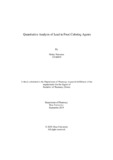| dc.contributor.advisor | Alam, Marzia | |
| dc.contributor.author | Nowreen, Nishat | |
| dc.date.accessioned | 2021-03-24T07:39:26Z | |
| dc.date.available | 2021-03-24T07:39:26Z | |
| dc.date.copyright | 2019 | |
| dc.date.issued | 2019-09 | |
| dc.identifier.other | ID 15146019 | |
| dc.identifier.uri | http://hdl.handle.net/10361/14377 | |
| dc.description | This thesis is submitted in partial fulfillment of the requirements for the degree of Bachelor of Pharmacy, 2020. | en_US |
| dc.description | Cataloged from PDF version of thesis report. | |
| dc.description | Includes bibliographical references (pages 22-24). | |
| dc.description.abstract | Lead poisoning occurs when lead builds up in the body, often over months or years. Even small amounts of lead can cause serious health problems. Children younger than 6 years are especially vulnerable to lead poisoning, which can severely affect their mental and physical development. At very high levels, lead poisoning can be fatal. The aim of this study is to find out levels of lead in food colors, which are commonly used in street food. According to WHO the maximum permissible limit of lead is 0.05 mg/L. Seven samples of food color were taken namely; S01 (green), S02 (yellow), S03 (chocolate), S04 (red), SS01 (green), and SS02 (yellow) SS03 (red). S01, S02, S03 and S04 were in solid form. Rest of the samples was in liquid form. To find the Pb levels in the samples, Direct Air-Acetylene Flame method was followed. The analysis showed that, out of seven samples, the Pb levels of four samples (S01, S02, S03 and S04) were out of limits which were respectively 0.15 mg/kg, 0.15 mg/kg, 0.15 mg/kg, and 0.10 mg/kg. Therefore, we can say that the usage of these colors can be harmful for us and cause severe toxicity. | en_US |
| dc.description.statementofresponsibility | Nishat Nowreen | |
| dc.format.extent | 24 pages | |
| dc.language.iso | en | en_US |
| dc.publisher | Brac University | en_US |
| dc.rights | Brac University theses are protected by copyright. They may be viewed from this source for any purpose, but reproduction or distribution in any format is prohibited without written permission. | |
| dc.subject | Lead | en_US |
| dc.subject | Heavy metals | en_US |
| dc.subject | Vulnerable | en_US |
| dc.subject | ICP-MS | en_US |
| dc.subject | Food colors | en_US |
| dc.subject.lcsh | Lead poisoning | |
| dc.subject.lcsh | Pharmacology | |
| dc.title | Quantitative analysis of lead in food coloring agents | en_US |
| dc.type | Thesis | en_US |
| dc.contributor.department | Department of Pharmacy, Brac University | |
| dc.description.degree | B. Pharmacy | |

